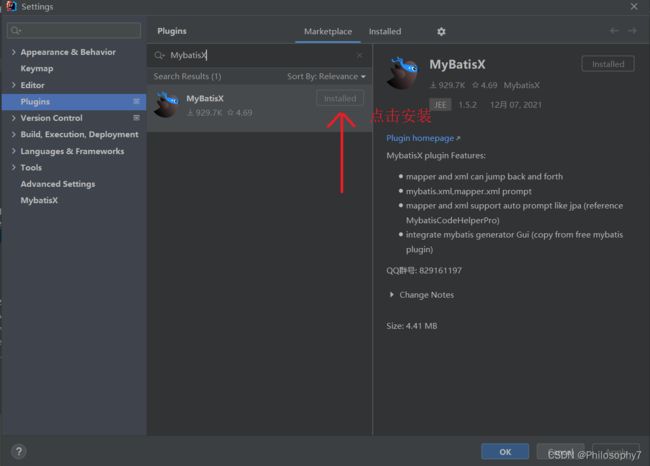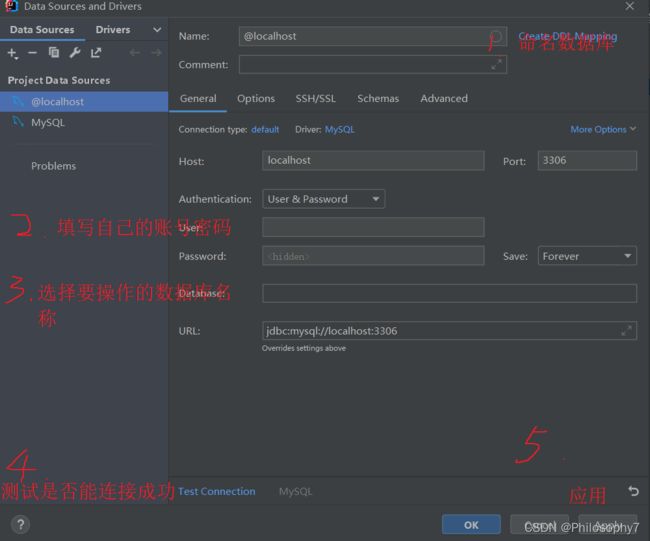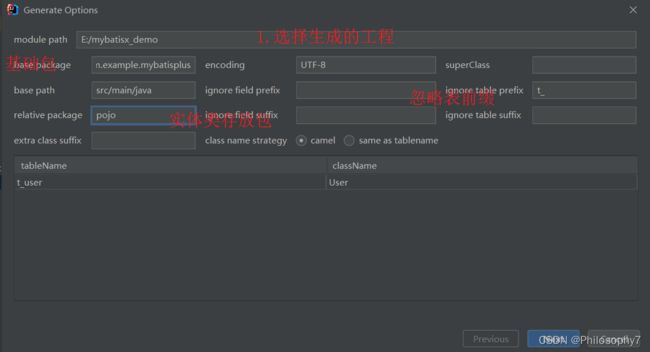MybatisPlus——多数据源和MybatisX插件(完结撒花)
完结撒花
- 一、多数据源
-
- 1、创建数据库和表
- 2、导入依赖
- 3、配置多数据源
- 4、创建实体类以及接口
- 5、创建用户Service
- 6、创建商品Service
- 7、测试
- 二、MybatisX快速开发插件
-
- 1、安装MybatisX插件
- 2、创建mapper目录
- 3、IDEA连接数据库
- 4、使用插件

适用于多种场景:纯粹多库、 读写分离、 一主多从、 混合模式等
目前我们就来模拟一个纯粹多库的一个场景,其他场景类似
场景说明:
我们创建两个库,分别为:mybatis_plus(以前的库不动)与mybatis_plus_1(新建),将 mybatis_plus库的product表移动到mybatis_plus_1库,这样每个库一张表,通过一个测试用例 分别获取用户数据与商品数据,如果获取到说明多库模拟成功
一、多数据源
1、创建数据库和表
CREATE DATABASE `mybatis_plus_1` /*!40100 DEFAULT CHARACTER SET utf8mb4 */;
use `mybatis_plus_1`;
CREATE TABLE product
(
id BIGINT(20) NOT NULL COMMENT '主键ID',
name VARCHAR(30) NULL DEFAULT NULL COMMENT '商品名称',
price INT(11) DEFAULT 0 COMMENT '价格',
version INT(11) DEFAULT 0 COMMENT '乐观锁版本号',
PRIMARY KEY (id)
);
INSERT INTO product (id, NAME, price) VALUES (1, '外星人笔记本', 100);
2、导入依赖
<dependency>
<groupId>com.baomidougroupId>
<artifactId>dynamic-datasource-spring-boot-starterartifactId>
<version>3.5.0version>
dependency>
3、配置多数据源
spring:
datasource:
dynamic:
# 设置默认的数据源或者数据源组,默认值即为master
primary: master
# 严格模式匹配数据源 默认为false true表示没匹配到数据源抛出异常
strict: false
datasource:
master:
url: jdbc:mysql://localhost:3306/mybatis_plus?characterEncoding=utf-8&useSSL=false
driver-class-name: com.mysql.cj.jdbc.Driver
username: root
password: 123
slave_1:
url: jdbc:mysql://localhost:3306/mybatis_plus_1?characterEncoding=utf-8&useSSL=false
driver-class-name: com.mysql.cj.jdbc.Driver
username: root
password: 123
4、创建实体类以及接口
import lombok.Data;
@Data
public class Product {
private Integer id;
private String name;
private Integer price;
private Integer version;
}
package com.atguigu.mybatisplus.pojo;
import com.baomidou.mybatisplus.annotation.TableId;
import com.baomidou.mybatisplus.annotation.TableLogic;
import com.baomidou.mybatisplus.annotation.TableName;
import lombok.Data;
@Data
@TableName("t_user")
public class User {
@TableId
private Integer uid;
private String userName;
private Integer age;
private Integer sex;
private String email;
private Integer ready_delete;
}
import com.atguigu.mybatisplus.pojo.Product;
import com.baomidou.mybatisplus.core.mapper.BaseMapper;
import org.springframework.stereotype.Repository;
@Repository
public interface ProductMapper extends BaseMapper<Product> {
}
package com.atguigu.mybatisplus.mapper;
import com.atguigu.mybatisplus.pojo.User;
import com.baomidou.mybatisplus.core.mapper.BaseMapper;
import org.springframework.stereotype.Repository;
@Repository
public interface UserMapper extends BaseMapper<User> {
}
5、创建用户Service
public interface UserService extends IService<User> {
}
@Service
@DS("master") //指定使用的数据源
public class UserServiceImpl extends ServiceImpl<UserMapper,User> implements UserService {
}
6、创建商品Service
public interface ProductService extends IService<Product> {
}
@Service
@DS("slave_1")
public class ProductServiceImpl extends ServiceImpl<ProductMapper,Product> implements ProductService {
}
7、测试
@SpringBootTest
public class MybatisPlusMultiDataSourceTest {
@Autowired
private UserService userService;
@Autowired
private ProductService productService;
@Test
public void testDynamicDataSource(){
System.out.println(userService.getById(1L));
System.out.println(productService.getById(1L));
}
}
二、MybatisX快速开发插件
MyBatis-Plus为我们提供了强大的mapper和service模板,能够大大的提高开发效率 但是在真正开发过程中,
MyBatis-Plus并不能为我们解决所有问题,例如一些复杂的SQL,多表 联查,我们就需要自己去编写代码和SQL语句,我们该如何快速的解决这个问题呢,这个时候可 以使用MyBatisX插件
MyBatisX一款基于 IDEA 的快速开发插件,为效率而生。
官方网站: MybatisX快速开发插件
1、安装MybatisX插件
file ---> settings -->Plugins
2、创建mapper目录
如果不去配置application文件 默认路径就必须为mapper/
小蓝鸟+小红鸟搭配 效率翻倍 !!!
3、IDEA连接数据库
使用MybatisX插件时,我们需要IDEA连接上数据库
4、使用插件
下一步选择对应的MybatisPlus版本,以及一些组件就可以生成代码了。
测试MybatisX快速开发生成CRUD
public interface UserMapper extends BaseMapper<User> { int insertSelective(User user); //Alt + enter 生成 int deleteByUidAndUserName(@Param("uid") Long uid, @Param("userName") String userName); }点击小红鸟就可以去往对应的映射文件当中 – 会生成对应的SQL语句







